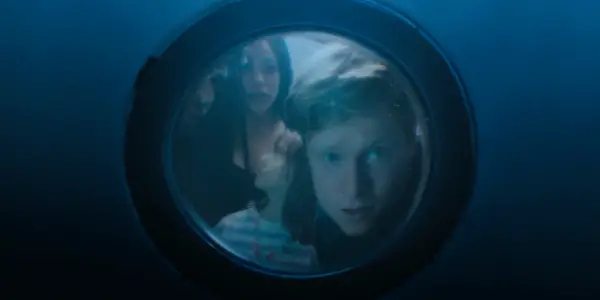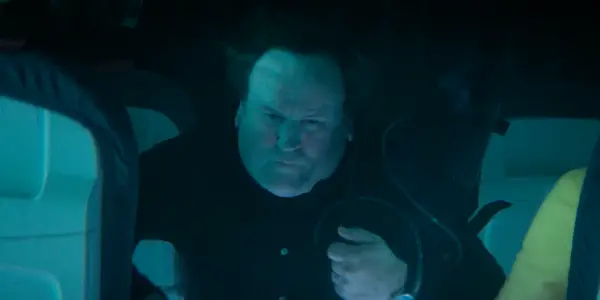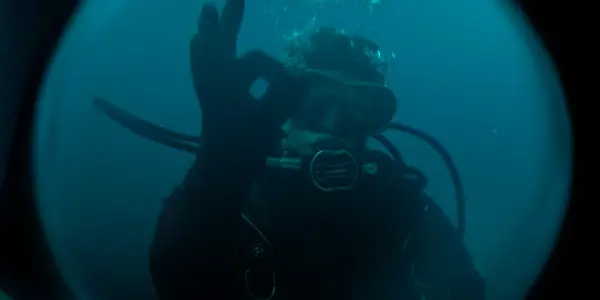NO WAY UP Represents The Democratization Of Bad Underwater Thrillers

Film critic, Ithaca College and University of St Andrews graduate,…
Underwater movies are having a moment right now. Somehow or another, we’ve reached a point in cinema history where anybody with a couple million dollars to spend can rent a water tank, submerge a set, and add some CG sharks in post if need be. Formerly the realm of big-budget blockbusters like The Abyss and Deep Blue Sea, the subgenre of underwater thrillers has been flooded in recent years with relentless low-budget pictures. Most of them involve sharks attacking people. Notable recent entries include Underwater, 47 Meters Down, 47 Meters Down: Uncaged, The Deep House, Great White, The Requin, The Dive, and now No Way Up.
Initially, I set out to review No Way Up. But one of my colleagues beat me to it, giving it a favorable review I’m not sure it deserves. Heaven knows it hardly tries. But this isn’t a movie you watch to see the effort on display, nor is it a film you watch hoping it’ll stir something within you. No, this is a movie you watch purely for the conceit: A group of people is trapped in a sunken airplane with rising water, a diminishing oxygen supply, hungry sharks at the door, and — pause for effect — no way up. Nothing of note happens in the entire film, and yet you watch anyway because you’re hooked on the premise.
Quietly, I’ll admit here — and I’ll admit it loudly in a court of law, if it comes to that — that the only reason I went out of my way to watch No Way Up instead of any of its contemporaries is completely arbitrary: This movie has Colm Meaney in it, and the others do not. But surfacing from the experience of watching nothing happening for an hour and a half and a couple of nobodies getting eaten by sharks, I was struck by the bigger picture, the larger cinematic wave that No Way Up is riding. Underwater thrillers have become staples of the movie industry, usually with low budgets to burn, pulp filmmakers at the helm, and so-so cast members who don’t have to try very hard given the low demands of the material.
This subgenre used to have some sort of class to it, some level of prestige, and now it’s almost all watered-down garbage. How did we get to this point? What, if anything, can No Way Up tell us about the status of its subgenre, the underwater thriller with an optional killer shark?
Survival Adventure At Its Least Exciting
Underwater thrillers don’t always overlap with creature features, but somewhere along the way, that became the norm. Some modern films don’t have any ferocious sea creatures at all — The Dive, for instance, manages to go its entire 90-minute-plus runtime without having a single eel, octopus, or shark lashing out at our heroes. Rare restraint for a genre where the middle of the road tends to be films like No Way Up, where the pitch meeting likely began and ended with “What if we put sharks on a plane?” Nevertheless, it’s convenient when the underwater thriller does become a creature feature. Having a monster to contend with excuses the screenplay from needing interesting characters — not since Jaws do I think any character has legitimately been interesting in a killer shark movie, and I certainly don’t remember the names of any of the characters in films like Sphere or The Meg.

By this line of inquiry, it follows that the actors don’t need to be interesting, either. Blake Lively might be on the posters for The Shallows, but she’d might as well get second billing below the shark. Sometimes, underwater thrillers have big names attached — The Meg, The Shallows, and Underwater are star vehicles, but for decades we’ve also had films like 1977’s Barracuda and 1989’s DeepStar Six, which don’t feature any stars at all. The characters (and the actors who play them) hardly matter in a subgenre where the cast list can be reduced to who is and isn’t shark chum.
No Way Up presents a classy example of this disinterest in character development. Our protagonist, Ava (Sophie McIntosh), is introduced as the daughter of the California governor. She’s on a trip to Cabo San Lucas with her friends, accompanied by her longtime bodyguard, Brendan (Colm Meaney). The script gently sets up some character flaws for Ava and even teases an arc — she’s trying to be more independent despite the smothering of her famous and overly protective father. But as soon as the pleasantries are out of the way, our cast becomes bland, their characterizations sloppy and reheated like an in-flight meal.
Accompanying Ava are her friends Jed (Jeremias Amoore) and Kyle (Will Attenborough), two jerks ready to party it up in Cabo. There’s a little girl (Grace Nettle) and her Nana (Phyllis Logan) and a flight attendant (Manuel Pacific) too. It’s hardly a compelling cast of characters on paper — at least other sunken thrillers like The Poseidon Adventure actually put effort into having diverse and interesting characters and then do crazy shit like throw them down elevator shafts.
Meaney and Logan play the most interesting folks aboard — as a gruff, omniscient bodyguard, Meaney actually has a sort of fun role, and Logan’s Nana is the only character whom we actually keep learning stuff about past the 20-minute mark. They inhabit important archetypes for the creature-feature film — respected veteran actors playing thankless roles with the tiniest bit of characterization. They usually get a big monologue about Themes. These archetypes, descendants of Robert Shaw‘s Quint in Jaws and Samuel L. Jackson‘s characters in Deep Blue Sea and Snakes on a Plane, balance out the mindless shark action and the hollow teen characters who always seem to be in these movies.

Even in the hands of Marlon Brando or Daniel Day-Lewis, this is a fucking plane crash of a script. And of course it is — it has exactly two check boxes to satisfy: Does the plane crash, and do sharks eat people? The subgenre puts such little caché into its characters and plot that basically anybody can write one. The writer of No Way Up is the ideal of such a screenwriter: This is Andy Mayson‘s first produced screenplay, and he himself is a longtime producer of schlock like this. He worked on Shark Bait, Great White, Black Water: Abyss, and the 47 Meters Down films. He knows the low bar he’s working with here, and he’s not trying to win any awards. He knows the low expectations of the underwater thriller — expectations that his own films have for a decade been working to cut down to the low, low standards they’re at now — and more importantly, he knows how to write to those low standards. This is more than just “another underwater shark movie.” This is the perfect case study of the modern underwater thriller.
The Role Of Logic And Science In Killer Shark Movies
You don’t need a Ph.D. in marine biology, physics, or screenwriting to know that nothing that transpires in No Way Up makes any sense. I’m not sure any other modern underwater thrillers would hold up to any sort of scrutiny, either. Yet there are two variables frustrating my hypothesis that anybody with a few million bucks to spend can make a shark attack movie. The first is that making CG sharks is hard. I’ll leave this argument to the special effects artists to debunk if they so wish. The second variable, one I’m more equipped to tackle, is that movies that take place underwater and deal with knowable things like divers and sharks have a certain shackle to logic and science. This is not far off from the same genre that famed explorer Jacques Cousteau launched in 1956 with The Silent World, after all. The sea and its creatures, as well as the exploration of it, might be fine fodder for storytellers, but it is also tightly entwined with scientific fields like marine biology and oceanography. For decades, big-budget movies about undersea exploration and oceanic terror fit within the sci-fi genre, and Jaws, Sphere, The Abyss, and Deep Blue Sea all feature scientist characters among their ensembles and concern themselves significantly with explaining the film’s plot and mechanics as we watch it.
Somewhere along the way, that framework was abandoned. Maybe it happened in the wave of cheap Jaws knock-offs like Orca, Piranha, and Jaws 2. In the 1970s and ’80s, underwater thrillers became less interested in appealing to high-brow, intellectual audiences with dialogue-driven stories, three-dimensional characters, compelling performances, and scientifically accurate plots and became more interested with who can make a bigger, meaner, deadlier shark than audiences saw in the last killer shark movie. It was like an arms race for underwater predators.
A film like No Way Up, however, is separable from SyFy Channel ilk like the Sharknado movies, if only because this one has the veneer of professionalism and the suggestion that it gives a shit. Most of the film takes place in a sunken plane with sharks outside the window, but there are still opportunities for scientific accuracy — and surprisingly, while the movie fails to make any logical sense, its scientific accuracy is commendably close to the truth.

The conditions for the plane to crash all make sense. Birds fly into the engine, which tracks because it seems to happen soon after takeoff and when the plane isn’t flying too high. Most bird strikes happen during takeoff or landing or during low-altitude flights, and I can’t imagine the trip from L.A. to Cabo we see in No Way Up requires very high altitudes. Because a plane has backup engines and can still fly and land safely if it loses an engine, the bird-stricken engine then explodes and shoots debris into the plane, ripping a hole in the side. That’s how the crash happens. As for the water landing, a quick look at FlightTracker confirms that most flights from LAX to Cabo take a brief trip over the Pacific about 10 miles from shore, where surprisingly the water is at the proper depth for the story to take place.
You can’t just make the plane crash in the open ocean and sink to the sea floor — the script feels engineered backward from the resolution, in which the surviving characters swim for the surface by simply holding their breath. If you’ve seen The Deepest Breath, in which Alessia Zecchini nearly drowns several times trying to free-dive over 100 meters, you know that no random teenage Cabo vacationer can make over 70 meters without an oxygen tank. So the depth needs to be deep enough that it’s scary, but shallow enough that they can still swim to the surface without their eyeballs popping out of their skulls. The California coastline provides a perfect setting for that, then — the maximum depth tends to be about 100 meters before the elevation suddenly hits a continental shelf and shoots down much deeper. The only issue here is that since we’re supposed to be 10 miles from the coastline, the wide shots of the ocean don’t show the plentiful boats I’m sure are sailing off the coast of California. One of those fishing boats, ferries, or private yachts would surely notice if a plane fell from the sky.
Sharksploitation
The most fantastical element of the film is undoubtedly the sharks. There’s probably a long line of nautical tales and sailor myths before Peter Benchley, the author of Jaws, came along, but Benchley made his name besmirching the reputation of sharks, like they beat him up on the playground as a kid and he never got over it. Jaws’ immediate popularity as both a novel and a film guaranteed that the Killer Shark trope transformed into a stalwart cinematic genre. And sure, some sharks have attacked people in the past, and there are some legitimately terrifying creatures you could make films about, like tiger sharks, notorious for eating anything they come across, be it a person, a seal, or a Florida license plate. But the sharks in No Way Up are parodies of parodies, stalking divers like Michael Myers and dragging poor Colm Meaney into the water just after he finishes making his dramatic final speech.
No Way Up treats its sharks like serial killers because it lacks the imagination to treat them as animals. Blame director Claudio Fäh for the way he lamely stages the shark action, bereft of both tension and nuance. Blame the screenwriter, Andy Mayson, for treating sharks like serial killers for his entire producing career.

For a way to make this underwater thriller more interesting, let’s look at a particularly boring Alfred Hitchcock movie, Lifeboat, which also strands a ragtag group of survivors in a single location. But rather than deploying killer sharks, Hitchcock uses the opportunity to force these characters into conflict based solely on their conflicting ideals, priorities, and backgrounds. It’s set during World War II, so who’s on what side is a constant source of tension. The film sets its seven characters under a microscope and studies them as a cross-section of the world at the time — watching Lifeboat, we can see what Hitchcock and his screenwriter, John Steinbeck, saw in American class, the frivolity of wealth, the absurdism of war, and the perils of infighting, all while attempting to articulate a broader, complex reading of a war in a picture that was released while Adolf Hitler was still alive. Compare this to No Way Up and Fäh and Mayson haven’t a single idea of what to do with these characters besides one implying that another is gay. American media outlets regularly say that this moment in time is the most divided America has been since the Civil War, and yet No Way Up has absolutely nothing to say about race, class, gender, sexuality, or politics. But at the same time, complaining about that feels like babysitting a 4-year-old and getting pissed off because they’re not registered to vote.
Conclusion
Truly anybody can make a movie like No Way Up now. We’re living in the era of the democratization of underwater shark thrillers. Against all odds, sharks have become ferocious cinematic nightmare fuel in the same way that Frankenstein’s monster and vampires have pervaded popular culture, and better yet, there’s no intellectual property to wrangle with to make a killer shark movie.
It goes without saying that these sorts of films are bad for environmental conservation efforts — nobody’s going to want to save the sharks if they kill Colm Meaney like that — but they might just be good for cinema on the whole. They’re proving grounds for young talent and efficient technical exercises for special effects teams. They employ niche positions in the filmmaking industry like dive teams and underwater cinematographers, and they keep alive uncommon but useful production skills like decorating, insulating, and lighting submerged sets.
The movie isn’t alone, either. The subgenre hasn’t slowed down since the last 47 Meters Down entry. Underwater thrillers have just migrated to alternate viewing platforms. Ten films involving killer sharks were released in 2023, not all of them American productions, on VOD and streaming sites like Tubi. Major theatrical releases like The Meg 2: The Trench keep the genre alive on the big screen. In 2024, after No Way Out, we’ll get at least one more killer shark thriller: Under Paris, a French Netflix title about a killer shark that somehow gets into the Seine and presumably starts eating French people. This might not be a good era of filmmaking to be in, but it’s the one we deserve.
Does content like this matter to you?
Become a Member and support film journalism. Unlock access to all of Film Inquiry`s great articles. Join a community of like-minded readers who are passionate about cinema - get access to our private members Network, give back to independent filmmakers, and more.
Film critic, Ithaca College and University of St Andrews graduate, head of the "Paddington 2" fan club.













